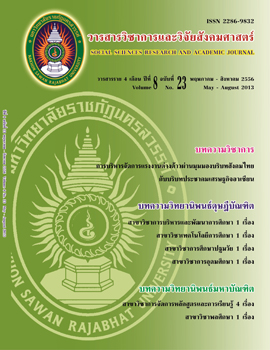การพัฒนาตัวบ่งชี้ภาวะผู้นำทางวิชาการสำหรับครูปฐมวัย สังกัดสำนักงานเขตพื้นที่การศึกษาประถมศึกษาในภาคตะวันออกเฉียงเหนือ
Main Article Content
Abstract
บทคัดย่อ
การวิจัยครั้งนี้มีวัตถุประสงค์เพื่อพัฒนาตัวบ่งชี้ภาวะผู้นำทางวิชาการสำหรับครูปฐมวัย สังกัดสำนักงาน เขตพื้นที่การศึกษาประถมศึกษาในภาคตะวันออกเฉียงเหนือ และเพื่อทดสอบความสอดคล้องของโมเดลโครงสร้างตัวบ่งชี้ภาวะผู้นำทางวิชาการสำหรับครูปฐมวัยที่พัฒนาขึ้นกับข้อมูลเชิงประจักษ์ การดำเนินการมีสองระยะประกอบด้วย ระยะแรก การพัฒนาตัวบ่งชี้ภาวะผู้นำทางวิชาการสำหรับครูปฐมวัย สังกัดสำนักงานเขตพื้นที่การศึกษาประถมศึกษาในภาคตะวันออกเฉียงเหนือ โดยการวิเคราะห์เอกสารและงานวิจัย การสัมภาษณ์ผู้ทรงคุณวุฒิ การศึกษารายกรณี จัดทำกรอบแนวคิดและร่างตัวบ่งชี้ ระยะที่สอง การทดสอบเพื่อยืนยันตัวบ่งชี้ภาวะผู้นำทางวิชาการสำหรับครูปฐมวัย โดยวิธีวิจัยเชิงปริมาณ เก็บข้อมูลจากกลุ่มตัวอย่างครูปฐมวัยจำนวน 580 คน และสถิติอ้างอิงวิเคราะห์ข้อมูลด้วยโปรแกรมสำเร็จรูปทางสถิติและโปรแกรมลิสเรล เครื่องมือที่ใช้ในการเก็บข้อมูลเป็นแบบสอบถามแบบมาตรวัดประเมินค่า 5 ระดับ มีค่าดัชนีความสอดคล้องระหว่าง 0.55-1.00 มีค่าความเชื่อมั่นทั้งฉบับ โดยวิธีสัมประสิทธิ์ แอลฟาของ Cronbach เท่ากับ 0.82 ผลการวิจัย พบว่า
1. ตัวบ่งชี้ภาวะผู้นำทางวิชาการสำหรับครูปฐมวัย สังกัดสำนักงานเขตพื้นที่การศึกษาประถมศึกษาในภาคตะวันออกเฉียงเหนือ ประกอบด้วย 3 องค์ประกอบหลัก 11 องค์ประกอบย่อย 68 ตัวบ่งชี้ จำแนกเป็น การบริหารจัดการหลักสูตรและการจัดการเรียนรู้ปฐมวัย จำนวน 14 ตัวบ่งชี้ การพัฒนาครูปฐมวัย จำนวน 26 ตัวบ่งชี้ และการพัฒนาเด็กปฐมวัย จำนวน 28 ตัวบ่งชี้ ซึ่งเป็นไปตามหลักการแนวคิด ทฤษฎีทีเกี่ยวข้อง
2. โมเดลโครงสร้างภาวะผู้นำทางวิชาการสำหรับครูปฐมวัย สังกัดสำนักงานเขตพื้นที่การศึกษาประถมศึกษา ในภาคตะวันออกเฉียงเหนือ มีความสอดคล้องกับข้อมูลเชิงประจักษ์ โดยมีค่าไค-สแควร์ (Chi-square) เท่ากับ 1.25 ค่าองศาอิสระ (df) เท่ากับ 4 ค่านัยสำคัญทางสถิติ (P-value) เท่ากับ 0.869 ค่าดัชนีวัดระดับความกลมกลืน (GFI) เท่ากับ 1.00 ค่าดัชนีวัดระดับความสอดคล้องที่ปรับแก้แล้ว(AGFI) เท่ากับ 0.99 และค่าความคลาดเคลื่อนในการประมาณค่าพารามิเตอร์ (RMSEA) เท่ากับ 0.000 (Chi-square = 1.25 df =4 ค่า P = 0.869 ค่า GFI = 1.00 ค่า AGFI =0.99 ค่า RMSEA =0.000) ซึ่งเป็นไปตามสมมติฐานที่ตั้งไว้
Abstracts
The purposes of this study were 1) to develop instructional leadership indicators for early childhood teachers under Offices of Primary Education Service Areas in the Northeast of Thailand, and 2) to examine goodness-of-fit between the developed hypothetical linear structure equation model of instructional leadership indicators and the empirical data. The study was conducted into two phases: phase 1 – development of instructional leadership indicators for early childhood teachers under Offices of Primary Education Service Areas in the Northeast of Thailand through analysis of related documents and research, interviews with experts, cases study, creating a conceptual framework, and doing a draft of indicators; phase 2 – testing in order to confirm instructional leadership indicators for early childhood teachers by quantitative research methodology. The data were collected from a sample of 580 early childhood teachers. A statistical package and the LISREL program were employed to analyze the data. The tool used to collect data was a 5-point rating scale questionnaire whose index of item-objective congruence (IOC) ranged between 0.55 and 1.00 and entire reliability coefficient by Cronbach’s method was 0.82. The findings were as follows:
1. The Instructional leadership indicators for early childhood teachers under Offices of Primary Education Service Areas in the Northeast of Thailand consisted of 3 principal components, 11 small components and 68 indicators which were divided into 14 indicators for curriculum management and early childhood learning management, 26 indicators for development of early childhood teachers, and 28 indicators for development of children in a preschool, which were based on related principles, ideas and theories.
2. The linear structure equation model of Instructional leadership indicators for early childhood teachers under Offices of Primary Education Service Areas in the Northeast of Thailand has goodness-of-fit with the empirical data as displayed by the statistical values as follows: Chi-square = 1.25, degree of freedom (df) = 4, p = 0.869, goodness-of-fit index (GFI) = 1.00, adjusted goodness-of-fit index (AGFI) = 0.99, and root mean square error of approximation (RMSEA) = 0.000. Thus, the study results confirmed the hypothesis stated.


